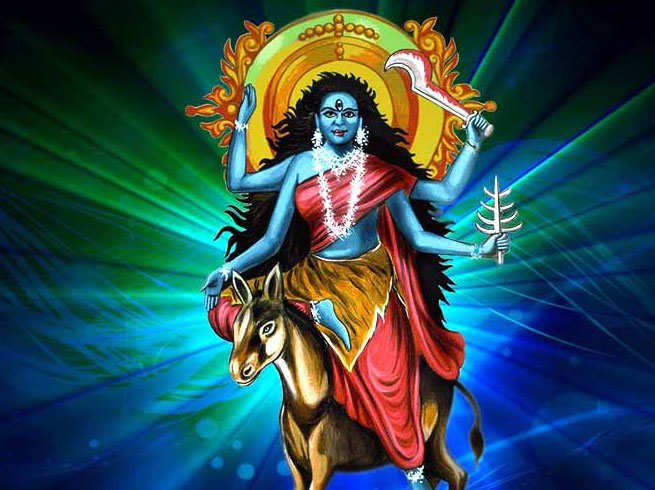On October 12th, 2024, Shardiya Navratri Day 7 will be dedicated to Goddess Kaalratri (Saptami). During the nine-day Navratri festival, the goddess Durga is honoured in nine different forms: Shailaputri, Brahmacharini, Chandraghanta, Kushmanda, Skanda Mata, Katyayani, Kaalratri, Mahagauri, and Siddhidatri.
Maa Kaalratri, Durga’s fiercest manifestation, is depicted riding a donkey and sporting a dark complexion and long, untied hair. She wears a skull garland around her neck and has four blood-splattered hands. She is wielding a scimitar and a thunderbolt, as well as abhaya (protection) and varada (blessing). Her name is a combination of the Sanskrit words Kaal and Ratri, which mean death and night, respectively. As a result, Kaalratri brings about the death of darkness.
Kaalratri’s Story
According to legend, the demons Shumbha and Nishumbha used Chanda, Munda, and Raktabeej to overthrow the gods and seize control of the three worlds. The appearance of Goddess Chandi, who was sent by Parvati to kill them, answered Indra’s and the other gods’ prayers. The goddess Chandi defeated Chanda, Munda, and Raktabeej, but they were unbeatable. Legend has it that Maa Kaalratri was born from the sweat of her brow at the time.
The Importance of Maa Kaalratri Worship
Maa Kaalratri is believed to protect her devotees from harm in Hinduism. During the Navratri festival, she is worshipped as a deity capable of banishing evil and bringing about world peace.
Worshiping Kalaratri, according to Hindu mythology, can help remove the negative effects of the planets in your life and bring you joy. Despite her fiery personality, she grants her devotees’ wishes and removes impediments in their path.
The Hindu festival of lights is known as Vidhi Puja.
To honour Maa Kaalratri, offer jaggery or food containing jaggery as prasad. On Saptami, devotees also perform the sringar puja, which includes sindoor, kajal, a comb, and hair oil, as well as shampoo, nail paint, and lipstick, as well as two sets of all makeup products. One set of the products is given as a gift to temples, while the other set is consumed as prasad by worshippers.


